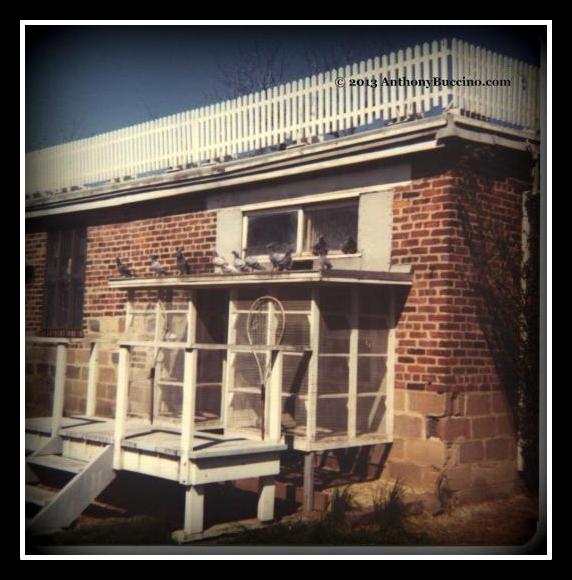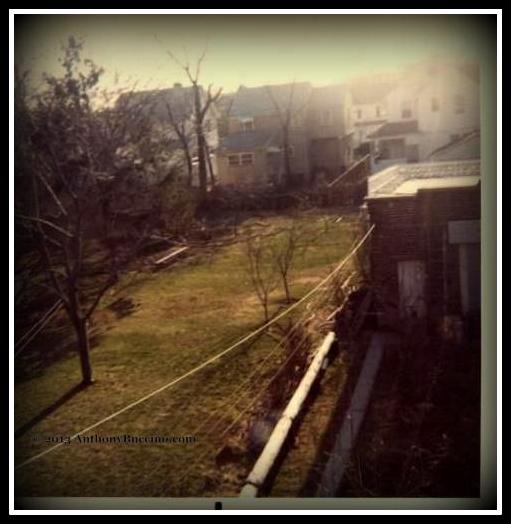First Robin of Spring and the Fifth Grade Science Project
by Anthony Buccino
A boy in a new neighborhood makes friends with a lost baby robin, feeding it, and teaching it to perch and take short flights. The bird says 'goodbye, kid' the way a bird knows how!
ANTHONY'S WORLD
Anthony Buccino
Essays, photography, military history, more
New Jersey author Anthony Buccino's stories of the 1960s, transit coverage and other writings earned four Society of Professional Journalists Excellence in Journalism awards.
Permissions & other snail mail:
PO Box 110252 Nutley NJ 07110
Follow Anthony Buccino
ROBIN
Carpenter Street, Belleville, N.J.
We saved a baby robin
from its fate of abandonment.
We used an eyedropper
and fed it milk-soaked bread
until it graduated
to pieces of worms from our garden
And we kept it in a spare canary cage
on our back porch
where the wind blew
in through the screens
And gave it water
and fed it
and watched it fly
from the shelf
to wooden Brookdale soda crates
to the newspaper piles
back to the shelf.
That red-breasted robin grew
and I taught it
to hold onto my finger
and later onto a stick
and then a branch I held out
And one time
when it was stronger
I took it into the yard.
Ma took a black and white picture
of that little bird and me
That was the day it flew
from the stick in my hand
to a low-hanging branch.
And like a foolish little brother
there I stood with my finger out
expecting the weightless robin
to come land again,
Be fed again
Return to its cage again
When I looked up
it flew over me
And shat, er, chalked
on my forehead
- By Anthony Buccino
© 2010 Anthony Buccino
Shop Amazon Most Wished For Items
Support this site when you buy through our Amazon link.
Part One
The only house my parents ever owned in Belleville was on
Carpenter Street, a narrow, one-way north street, from Belleville
Avenue to Continental Avenue, with houses on the left side and on
the right, behind a barb-wire topped six-foot fence, grassy fields
and a few rolling hills led to the iconic Isolation Hospital with
the verdigris peaked roof visible from tall mountains far, far
away, and the private golf course across the valley in Bloomfield.

The
south end of the street had a brick house on the right hand side,
before the grounds swept up to the hospital. Then the fence started.
On the right, came a few late model single family houses, then two
sets of garden apartments on Carpenter Terrace South and then
Carpenter Terrace North.
We lived beyond the apartments, in the eighth house (at the
time) on the left.
Our immediate neighbor to the south lived in a house set
back a long way from the street and had its front obscured by
prize-winning mimosa trees and a thick, overgrown hedge. Most
drivers who were looking for that house almost always drove by and
had to back up against the one-way when they saw our house. That
house was also the bane of mailmen as the two story bungalow was at
the far end of a dirt driveway that turned to muddy troughs in
inclement weather.
Between the hidden bungalow next door and our red and gray
house, we owned a long slender lot that stretched back more than
two-hundred feet to our neighbors on Fairway, and added to the
park-like setting of our Hermitage. When we looked across the street
we saw the wide open field, then a distant copse of pine trees
before the berm obliterating any sense of the busy cars rushing
along Franklin Avenue.
That barb wire topped six-foot fence deterred most
trespassers, but we kids dug a hole, here or there and scooted under
the hard sharp wires whenever we wanted to play football, field
hockey or homerun derby.
At the far end of our yard, behind the oversized garage was
an abandoned chicken coop. My dad tore down the wooden structure and
left the old stone block foundation just in case he wanted to put up
a pigeon coop at that site. But because our yard held the largest
garage you ever saw in a private yard – it was big enough to store
at least a dozen cars – it blocked any view of the coop that would
have stood behind it had my carpenter dad decided to build there.
My dad was big on birds. He loved his pedigree homing
pigeons. On Carpenter Street, we always had two trays of water fresh
and available for the wild birds. And mom always saved the bread
loaf ends to toss out to the birds that gathered in our black walnut
and mimosa trees, and the various rose and what-not bushes that ran
along the property line between our house and the bungalow next
door.
From the time he was a whirling dervish and into young
manhood, dad had homing pigeons. When he was overseas during World
War Two and got leave in Australia, he walked the neighborhoods
scouting out their pigeon coops. So, one of his main reasons for
buying the home on Carpenter Street was it's location – for the
homing pigeons. With two golf courses to the east and west and the
hospital grounds across the street, his birds would have been
hard-pressed to find a reason to miss their coop when coming home
from a race.
A corner of the garage was converted into a pigeon coop and
the water troughs filled for the wild birds that gathered to eat our
cast off bread, and we sat as specks on the giant lawn that took
more than an hour to mow each week, enjoying the prettyish kind of
wilderness. And one day in our first spring in that new home on
Carpenter Street, under our giant walnut tree one day appeared a
baby robin which is where this story begins.
Part Two
Our side yard on Carpenter Street had plenty of trees,
mimosas and black walnut mostly. The former blossom pretty pink
flowers when they are ready. The black walnut trees drop golf ball
sized nuts with their coarse, thick green skins, apparently to ease
their landing.

The
padded coating comes in handy when a walnut – or a bunch of walnuts
on stem – drops 50 feed and lands on your head. It’s embarrassing,
and stings for a while, but leaves nothing longer lasting than a
green skid mark on your head, and perhaps a little bump.
Step out the side door into the lot and there’s that big
black walnut tree. It served as the base for Ma’s clothesline that
ran out through the air to the far mimosa in the center of the side
lot and looped back again.
One day, under that tall black walnut tree we found a baby
robin on the ground. Perhaps a storm blew by and whisked it out of
the nest. Or a squirrel shook the branch, or perhaps some green
black walnut hit the nest and trampolined the bird in to the sky
sending the ball of fluff through the air – a bit ahead of schedule
– to land unceremoniously on the soft pile of grass clippings.
The robin was young, very young and frail, but not so frail
that we couldn’t pick it up and transfer it to a spare canary cage
and tend to the bird, proffering it milk-soaked bread from an eye
dropper.
So, that was my job, feeding the little bird, and I shared
the job with whoever else was around, mom, dad or my teenaged
sister. We could have pretended we were all living on a farm. We all
looked after the wild helpless little robin as it grew stronger and
flew from perch to perch building its wing muscles while railing
against the cruel and unwarranted imprisonment behind these chrome
bars.
After growing up with dad’s homing pigeons, picking up and
gently holding a robin was really nothing, like holding a handful of
soft, scared, sacred air.
This would have made a great science project for Mrs. James'
Fifth Grade class
at School 10 where I barely squeaked by, she said, after I learned
everything wrong n my old parochial school.
Heck, I wasn’t used to picking
out clothes to wear to school every day instead of my tie and
uniform and she expected me to remember everything that was drilled
into my head by the habited ones. Leaving that old school was a lot
like being paroled. I had a new life in a new house. I could make
new friends and the first thing I did was forget what went before.
In September, I entered Fifth Grade after the
tabula rasa
summer of 1964.
What would I know about a science project? How’s this: If
you’re really good all your life, when you die, you get to live
again. That should have been my Fifth Grade science report. Instead,
I took some scrap wood from the giant garage, tapped in some
finishing nails and strung some rubber bands from nail to nail and
called it an instrument.
Picture a Charles Brown Christmas tree as a science project.
Got that picture in your head? His tree would have been an A-plus
next to my scrap of wood.
At the science fair where we all got to show off our science
projects, the kid down the block had created a real volcano that
exploded and shot out sparks and lava. I had a cast-off piece of
window moulding with big brads sticking out catching on everything
and anyone who walked too closely by, topped by rubber bands
stretched out to the max and about to snap when you least expect it.
"Can you play a tune on that thing, Anthony?"
"No, ma'am, I don't know music," I said flatly.
Maybe if I had more time to work on the project? You can be
sure the teacher told us the night before that the project was due,
so, that’s when I did it.
Don’t go taking the teacher’s side that she told us weeks
and months ahead of the due date. (This is my flashback aside, and
I’ll tell it the way I remember it. You’ll have to make up your own
stories.) I’m sure she told us the afternoon before, “Don’t forget,
children, your science projects are due tomorrow.”
 In
retrospect, if I had the foresight to show I could save one wild,
red-breasted robin, then I might have been able to bring up my
science grade and gone on to become a famous scientist instead of
you-know-what.
In
retrospect, if I had the foresight to show I could save one wild,
red-breasted robin, then I might have been able to bring up my
science grade and gone on to become a famous scientist instead of
you-know-what.
The little bird and I got along well. I think it was happy
to see me – not that you could see it smile, it was happy to see me
in the same was it was happy our dog Butch didn’t eat it when I held
it to his nose for a sniff.
And that feathered critter helped me get to know some of the
neighborhood kids. They all came by at one time or another to check
out my little charge flitting from perch to perch in the spare
canary cage.
If I ever did a science project, I would have stood in front of the class and said how we fed the gossamer waif. Yes, we soaked bread in milk and at first had to feed it with an eye-dropper. It was just like in those cartoons we all watched, with its mouth as wide as a steam shovel bucket and twice as hungry.
As the
North
American Robin (Turdus migratorius) is a migratory songbird of the
thrush
got
bigger, we disposed of the dropper and fed it small clumps of soggy
bread.
Then we worked up to some of the small seeds from dad's
pigeon feed and bits of earth worm. Of all that we fed the baby
bird, the worms were the weirdest. They were skin on the outside and
dirt on the inside. At lest the soggy milk-bread reminded us of
something we might eat ourselves, like our morning sugar frosted
flakes.
One day when the robin was stronger and its angel hair down
cover given over to fine feathers, I released it from the cage and
watched it soar and zip and climb and land on a shelf here, the
wooden Brookdale soda crate over there on our screened-in porch.
It liked that. It wasn’t all that interested in flying to my
outstretched finger. But I had him again and my mom got the camera
to take a photo of me and my bird under the tree where we found it.
I settled it and kept it calm, and held my hand out as Mom
snapped the Kodak.
The bird flew to a low hanging branch in the black walnut
tree. I stuck out my finger and waited as if it was a trained falcon
like on Disney. The robin didn’t come to me, so I whistled, held my
hand out higher and eyed the robin in the branch just out of reach.
It watched me back.
At last, the red breasted robin left its branch, flying towards me, then shot straight up winging over my head leaving a white wet chalk mark of robin poop on my forehead, disappearing forever into the back pages of a young boy.
Adapted from Greetings from Belleville, New Jersey, Collected writings by Anthony Buccino
The
first robin of spring first published
Belleville-Nutley Patch on May 9 and May 10, 2011
The
short version
of this story
© 2011 by Anthony Buccino
Read more Back To School!
You might also like:
Bad Haircut: Stories from the Seventies by Tom Perrotta
Joe College: A Novel by Tom Perrotta
Shop Amazon Most Wished For Items
Web site will receive a stipend for purchases through the Amazon link
Support this site when you buy through our Amazon link.





